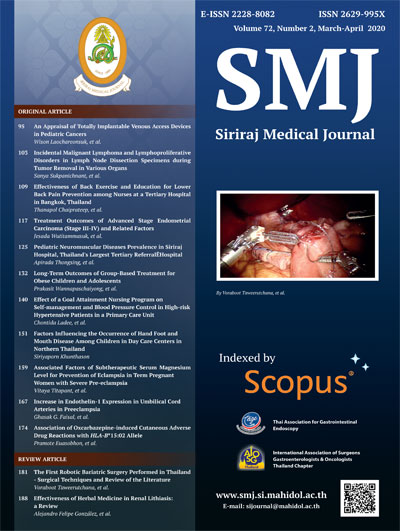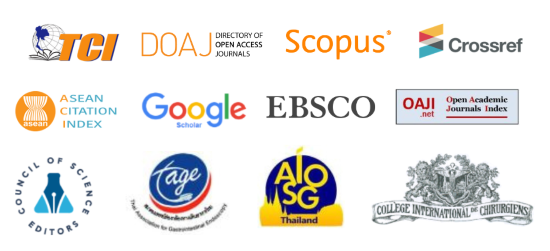An Appraisal of Totally Implantable Venous Access Devices in Pediatric Cancers
DOI:
https://doi.org/10.33192/Smj.2020.13Keywords:
Totally implantable venous access device; longevity; complications; pediatric cancerAbstract
Objective: To appraise the experience of a pediatric cancer center in Thailand regarding employment of totally implantable venous access devices (TIVAD).
Methods: The records of consecutive patients aged less than 15 years diagnosed malignancy and underwent an implantation from the years 2010 to 2018 were reviewed with the main focus on effective duration and complications of the device. Changes in our practice in perioperative care were also reviewed.
Results: A total of 150 lines in 144 patients (103 hematologic malignancies and 41 solid tumors) were included with average age 6.4 years. Neck vein access was used in 62 lines, subclavian vein access in 88 lines. The median follow-up period was 973 days. Immediate complications occurred in 13 cases (9.4%). Excluding cases with death from unrelated causes, the overall TIVAD survival was 985.1 days while event-free device survival was 797.6 days. In cases of hematologic malignancies, which were the main users, 1000-day overall survival and event-free survival of TIVAD were 83.7% and 78.2%, respectively. Catheter-related infections and mechanical obstruction were the 2 most prevalent problems, occurring in 0.20 and 0.08 events/1,000 catheter days, respectively. Infection occurred in 23 patients and gram-negative bacilli were most common. Moreover, subclavian access was significantly related with infectious complications when compared to the neck vein approach.
Conclusion: A TIVAD can be used for chemotherapy longer than 3 years without serious complications. Refinement of surgical techniques and improving care process may improve the longevity of the line.
References
2. Teichgraber UK, Pfitzmann R, Hofmann HA. Central venous port systems as an integral part of chemotherapy. Dtsch Arztebl Int 2011;108:147-53.
3. Esfahani H, Ghorbanpor M, Tanasan A. Implantable Port Devices, Complications and outcome in Pediatric Cancer, a Retrospective Study. IJPHO 2016;6:1-8.
4. Granziera E, Scarpa M, Ciccarese A, Filip B, Cagol M, Manfredi V, et al. Totally implantable venous access devices: retrospective analysis of different insertion techniques and predictors of complications in 796 devices implanted in a single institution. BMC Surg 2014;14:27.
5. Wu S, Huang J, Jiang Z, Huang Z, Ouyang H, Deng L, et al. Internal jugular vein versus subclavian vein as the percutaneous insertion site for totally implantable venous access devices: a meta-analysis of comparative studies. BMC Cancer 2016;16:747.
6. Lin WY, Lin CP, Hsu CH, Lee YH, Lin YT, Hsu MC, Shao YY. Right or left? Side selection for a totally implantable vascular access device: a randomised observational study. Br J Cancer 2017;117:932-7.
7. Hsu CC, Kwan GN, Evans-Barns H, Rophael JA, van Driel ML. Venous cutdown versus the Seldinger technique for placement of totally implantable venous access ports. Cochrane Database Syst Rev 2016;(8):CD008942.
8. Di Carlo I, Pulvirenti E, Mannino M, Toro A. Increased Use of Percutaneous Technique for Totally Implantable Venous Access Devices. Is It Real Progress? A 27-Year Comprehensive Review on Early Complications. Ann Surg Oncol 201017:1649-56.
9. Ignatov A, Hoffman O, Smith B, Fahlke J, Peters B, Bischoff J, et al. An 11-year retrospective study of totally implanted central venous access ports: Complications and patient satisfaction. Eur J Surg Oncol 2009;35:241-6.
10. Pinelli F, Cecero E, Degl’Innocenti D, Selmi V, Giua R, Villa G, et al. Infection of totally implantable venous access devices: A review of the literature. J Vasc Access 2018;19:230-42.
11. Intagliata E, Basile F, Vecchio R. Totally implantable catheter migration and its percutaneous retrieval: case report and review of the literature. G Chir 2017;37:211-5.
12. Song IK, Kim EH, Lee JH, Jang YE, Kim HS, Kim JT. Seldinger vs modified Seldinger techniques for ultrasound-guided central venous catheterisation in neonates: a randomised controlled trial. Br J Anaesth 2018;121:1332-7.
13. Cajozzo M, Palumbo VD, Mannino V, Geraci G, Lo Monte AI, Caronia FP, et al. Ultrasound-guided port-a-cath positioning with the new one-shoot technique: thoracic complications. Clin Ter 2018;169:e277-e80.
14. Devrim İ, Oruç Y, Demirağ B, Kara A, Düzgöl M, Uslu S, et al. Central line bundle for prevention of central line–associated bloodstream infection for totally implantable venous access devices (ports) in pediatric cancer patients. J Vasc Access 2018;19:358-65.
15. Piredda M, Biagioli V, Giannarelli D, Incletoli D, Grieco F, Carassiti M, et al. Improving cancer patients’ knowledge about totally implantable access port: a randomized controlled trial. Support Care Cancer 2016;24:833-41.
16. Seifert H, Cornely O, Seggewiss K, Decker M, Stefanik D, Wisplinghoff H, et al. Bloodstream infection in neutropenic cancer patients related to short-term nontunnelled catheters determined by quantitative blood cultures, differential time to positivity, and molecular epidemiological typing with pulsed-field gel electrophoresis. J Clin Microbiol 2003;41:118-23.
17. Nagasawa Y, Shimizu T, Sonoda H, Mekata E, Wakabayashi M, Ohta H, et al. A comparison of outcomes and complications of totally implantable access port through the internal jugular vein versus the subclavian vein. Int Surg 2014;99:182-8.
18. Tagliari AP, Staub FL, Guimarães JR, Migliavacca A, Mossmann DdF. Evaluation of three different techniques for insertion of totally implantable venous access device: A randomized clinical trial. J Surg Oncol 2015;112:56-9.
19. Vidal M, Genillon JP, Forestier E, Trouiller S, Pereira B, Mrozek N, et al. Outcome of totally implantable venous-access port-related infections. Med Mal Infect 2016;46:32-38.
20. Lebeaux D, Fernández-Hidalgo N, Chauhan A, Lee S, Ghigo JM, Almirante B, et al. Management of infections related to totally implantable venous-access ports: challenges and perspectives. Lancet Infect Dis 2014;14:146-59.
21. Zerati AE, Figueredo TR, de Moraes RD, da Cruz AM, da Motta-Leal Filho JM, Freire MP, et al. Risk factors for infectious and noninfectious complications of totally implantable venous catheters in cancer patients. J Vasc Surg Venous Lymphat Disord 2016;4:200-5.
Downloads
Published
How to Cite
Issue
Section
License
Users are free to share, copy, and redistribute all articles published in the Siriraj Medical Journal (SMJ) in any medium or format as long as you follow the following terms:
- Attribution — You must give appropriate credit, provide a link to the material, and indicate if changes were made. You may do so in any reasonable manner, but not in any way that suggests the publisher endorses you or your use.
- NonCommercial — You may not use the material for commercial purposes.
- NoDerivatives — If you remix, transform, or build upon the material, you may not distribute the modified material.
- No additional restrictions — You may not apply legal terms or technological measures that legally restrict others from doing anything the license permits.











